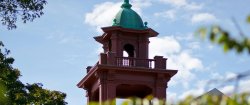When the Wild West is the College Lab
Earth and Environmental Science majors study in the natural geologic laboratory of the Rockies
Posted in: Homepage News, Science and Technology

After a year of pandemic challenges, Earth and Environmental Science majors took advantage of the world slowly reopening to travel this summer to Montana and Wyoming, where the wonders of the northern Rockies were a welcomed laboratory after a year of virtual learning.
Associate Professor Matthew Gorring led the expedition with students in the Field Geology course gaining hands-on experience in geologic mapping of bedrock and glacial deposits.
“Sometimes out West you’ll get surprised, not by the geology, but just by the wildlife that you come across,” Gorring says.
The summer course took place from May 24 to June 29, offering a mix of natural labs. Before heading west, the students focused on the environmental geology and hydrology projects at a preserve walking distance from the Montclair State campus.
Photos shared by the class – seniors Matt Voelker, Ryan Munson, Matthew Munson and juniors Patrick Tuohey, Ashley Greiss, Kristen Kakascik, Rebecca Radigan, Alex McLaughlin – show the spectacular beauty of their summer laboratory.

Students at Beartooth Pass at 10,947 feet above sea level. There was considerably less snow compared to previous years; usually in early June the sign is barely poking out of the snowpack.

Students examine road cut exposure of the 3 billion-year-old metamorphic rocks along the Beartooth Highway near Red Lodge, Montana. These are some of the oldest rocks on planet Earth.

The class relaxes along Clarks Fork of the Yellowstone River with views of Pilot Peak, left, and Index Peak. Pilot Peak is a classic example of a horn carved by glaciers that existed in this area during the last Ice Age about 10,000 years ago.

Students relax on a huge boulder looking up the Clarks Fork Canyon. The U-shaped valley was carved by a large glacier flowing out of the Beartooth Range during the last Ice Age 10,000 years ago.

Alex McLaughlin, Rebecca Radigan and Matt Voelker collect data on the Cambrian (~500 million years old) Gros Ventre Formation.

Brothers Ryan and Matthew Munson collect data on a very large pillar of vertical Chugwater Formation with the gigantic monoclinal fold of Paleozoic rocks on the opposite side of the Clarks Fork Canyon.

Students enjoyed the outdoors, including the beautiful Grand Prismatic Spring in the Midway Geyser Basin in Yellowstone National Park.
Story by Staff Writer Marilyn Joyce Lehren
You May Also Like:
